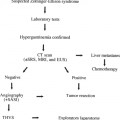
Chronic Infusion Catheters: An Oncologist’s Perspective
There are two types of indications for chronic venous access in oncologic management: therapeutic and supportive. In a given patient, these needs are not mutually exclusive. In fact, the distinction may be a bit arbitrary because in oncology, as in much of medicine, what can be done therapeutically depends a great deal on how well the resultant pathophysiologic consequences can be supported and tolerated.
In this chapter, therapeutic indication refers to the need for chronic, safe, reliable venous access either to administer the drugs required or to administer them in a way that would not be possible without such venous access (Table 28–1). Supportive indications address the need for chronic, safe, reliable venous access to obtain frequent blood samples or to administer fluids, electrolytes, parenteral alimentation, antibiotics, blood products, cytokines, or other pharmacologic reagents as may be required to support disrupted organ system physiology while waiting for response to treatment and recovery from treatment toxicity (Table 28–2). These needs may arise in widely different treatment contexts, and these differences should be considered by the consulting radiologist as intervention is planned and executed.
 Putting the Consult in Context
Putting the Consult in Context
The radiologist will best be able to fulfill his or her role as a physician in planning percutaneous placement of the chronic venous catheter when all of the following are understood:
1. The patient’s diagnosis, previous management (and results), the currently planned management, and the intent (curative or palliative) and status (standard or investigational) of the planned management
2. Why chronic venous access is necessary to permit or facilitate continued patient management
3. Relevant details of past medical history, including family history, or existing comorbidities (and their management) that impact on interventional radiologic management
4. The patient’s current emotional, physical, and psychologic status relevant to the planned procedure, as judged by the history, physical examination, and review of available laboratory and imaging data
5. The importance as well as the limitations of his or her role as a physician in the patient’s management.
Let us take a closer look at some of these background and management issues.
 Diagnosis, Intent, Previous and Planned Management
Diagnosis, Intent, Previous and Planned Management
Patients and families will expect the radiologist to be “oriented” and conversant with their medical status and therapeutic plan. Understanding diagnosis, past management, planned management, and intent of management is therefore essential for comfortable communication as well as technical planning. Diagnosis provides insight to the organ system(s) potentially involved. In this context, implicit to the concept of diagnosis is the concept of “stage” of disease. Staging is a shorthand way of summarizing the extent of clinically evident local, regional, and hematogenous tumor spread for lymphomas and so-called solid neoplasms. Details of dissemination may be important in catheter placement, either because of the alteration of normal vascular anatomy or because of a desire to avoid catheter placement in areas of planned or previous high dose (e.g., greater than 4500 cGy) irradiation.
Standard chemotherapy ± inadequate peripheral veins Permit safer use of vesicant drugs Patient refuses repeated venipuncture Pediatric patient Reliable venous access for brief infusion not available Continuous infusion chemotherapy (days/weeks/months) Increase therapeutic effect Decrease toxicity Permit out patient administration |
Intent of management must be kept in mind. “Curative” intent implies a measurable possibility of expected long-term disease-free survival, that is, “cure.” Palliative management is aimed at temporary disease regression or symptom relief.
Intent of treatment should not be confused with whether the treatment is investigational or standard. Investigational treatment may be either curative or palliative in intent and likewise for standard treatment.
The terms adjuvant and neoadjuvant
Stay updated, free articles. Join our Telegram channel

Full access? Get Clinical Tree



